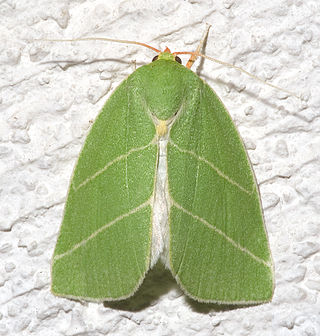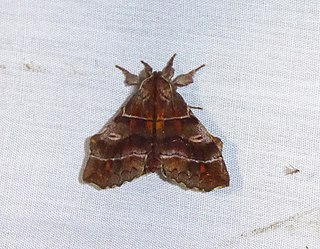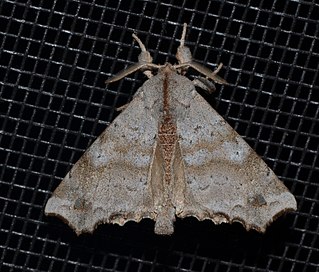
The pine beauty is a moth of the family Noctuidae. It is a common species of pine woods in Europe. The distribution area extends from Portugal to western Siberia, the Caucasus and Asia Minor. In the north it extends to the Arctic Circle, in the south it is found in Ceuta in Northern Africa in and southern Italy.

Apatelodidae, the American silkworm moths, is a family of insects in the order Lepidoptera. They are a family within the superfamily Bombycoidea, though they have in the past been considered a subfamily of Bombycidae.

Bena bicolorana, the scarce silver-lines, is a moth of the family Nolidae. The species was first described by Johann Kaspar Füssli in 1775. It is found in Europe Turkey, Armenia, Asia Minor and Syria.

Xanthia togata, the pink-barred sallow, is a species of moth of the family Noctuidae. It is a Holarctic species, and is found throughout Europe and east through the Palearctic to Central Asia, and Siberia up to the Ussuri. The distribution area includes the United States and Canada. It was first described by the German entomologist Eugenius Johann Christoph Esper in 1788 from the type specimen in Germany

Spilosoma lubricipeda, the white ermine, is a moth of the family Erebidae. It is found throughout the temperate belt of Eurasia from Europe through Kazakhstan and southern Siberia to Amur Region, China, Korea and Japan. In China several sibling species occur.

Noctua fimbriata, the broad-bordered yellow underwing, is a moth of the family Noctuidae. It is found in Europe, North Africa, Anatolia, the Caucasus, Turkey, Caucasus, Transcaucasia, Armenia, Turkmenistan and Novosibirsk Oblast. The border of its southern range is unclear because of the similar looking species Noctua tirrenica.

Anarta myrtilli, the beautiful yellow underwing, is a moth in the family Noctuidae. The species was first described by Carl Linnaeus in 1761. It is found in most of Europe including Scandinavia, Britain, France, Germany, Switzerland, Spain, Portugal, Italy, and Russia.
Falcatelodes is a monotypic genus of moths of the family Apatelodidae. It was erected by Max Wilhelm Karl Draudt in 1929, and contains a single species, Falcatelodes anava, which was first described by Herbert Druce in 1890.
Thelosia is a genus of moths of the Apatelodidae family. It was first described in 1896 by William Schaus, containing at the time three species: Thelosia phalaena, T. camina and T. truvena. Since then, several additional species have been described.

Thyrioclostera is a genus of moths of the family Apatelodidae which was erected in 1929 by Max Wilhelm Karl Draudt. It is monotypic, having a single species, Thyrioclostera trespuntada originally described as Callopistria trespuntada by Paul Dognin in 1894, and which is known from Ecuador and Peru.

Zanola is a genus of moths in the family Apatelodidae.
Thelosia jorgenseni is a moth in the Apatelodidae family. It was described by William Schaus in 1927. It is found in Paraguay.
Thelosia mayaca is a moth in the Apatelodidae family. It was described by William Schaus in 1939. It is found in Peru.
Thelosia meldola is a moth in the Apatelodidae family. It was described by William Schaus in 1900. It is found in Brazil (Parana).
Thelosia minois is a moth in the Apatelodidae family. It was described by William Schaus in 1892. It is found in Brazil.
Thelosia truvena is a moth in the Apatelodidae family. It was described by William Schaus in 1896. It is found in Brazil.
Thelosia impedita is a moth in the Apatelodidae family. It was described by Harrison Gray Dyar Jr. in 1928. It is found in Brazil.
Thelosia postflavida is a moth in the family Apatelodidae. It was described by Max Wilhelm Karl Draudt in 1929, with a type locality in Brazil.

Olceclostera is a genus of moths of the family Apatelodidae.
Gaurena florens is a moth in the family Drepanidae. It is found in Nepal, India, Myanmar, China, Bhutan, Vietnam and Thailand.









